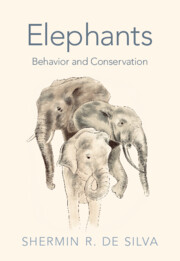4 - Reproduction and Male Social Relationships
Published online by Cambridge University Press: 12 December 2024
Summary
Elephants are a textbook example of slow-breeding megafauna, with extended periods of maternal investment and a long reproductive lifespan among both sexes. The unique reproductive physiology of females gives rise to the uniquely proboscidean phenomenon of “musth” among males, a rut-like breeding state. This chapter examines how female reproductive constraints and life histories impose constraints on males, who in turn must trade off the need to forage with the need to breed. These dueling motivational states give rise to tactics that vary at different life history stages. Tusks, another iconic feature of elephants, may be thought to offer competitive advantages, but the case is not so clear when one considers their liabilities. The chapter concludes by contrasting the demographic pressures on elephants due to habitat loss, conflict, and hunting, and the possible hidden costs that might influence the viability of elephant populations.
Keywords
- Type
- Chapter
- Information
- ElephantsBehavior and Conservation, pp. 66 - 100Publisher: Cambridge University PressPrint publication year: 2024

